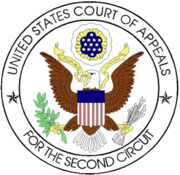- DeMarco v. Holy Cross High School
-
DeMarco v. Holy Cross High School 
Court United States Court of Appeals for the Second Circuit Full case name Guy DeMarco v. Holy Cross High School Date decided September 1, 1993 Citation(s) 4 F.3d 166 (2nd Cir. 1993) Judge(s) sitting John M. Walker, Jr., Joseph M. McLaughlin, and Thomas P. Griesa Case opinions Unanimous: Walker Citation: 4 F.3d 166 (2nd Cir. 1993)
Appellee: Holy Cross High School
Appellant: Guy DeMarco
Contents
Facts
Appellant was employed as a lay instructor. Under the terms of his contract of employment, his employment was to last five years with the option to extend that employment in five-year increments at the discretion of the employer. Upon completing his first five-year term of service, appellant was advised that a contract renewal would not be offered to him. At the end of the school, he left the employment of the appellee.[1]
Procedural History
A complaint was filed with the Equal Employment Opportunity Commission. The complaint alleged violation of the Age Discrimination in Employment Act. The EEOC subsequently determined that no violation of the ADEA had occurred.[2]
A lawsuit was filed in the United States District Court for the Eastern District of New York, alleging age discrimination. The appellee filed a motion for summary judgment, claiming that the non-renewal of the appellant's contract was due to performance issues. Specifically, it was claimed that the appellee did not begin his classes with prayer or attend mass with his students. The appellant argued that summary judgment would be appropriate because enforcement of labor statutes against religious organizations was unconstitional under the establishment clause of the First Amendment. The district court granted summary judgment.[3]
The decision of the district court was appealed, resulting in this decision
Question Presented
Does the ADEA apply to religious schools?[4]
Answer
Maybe. ADEA can only apply to an employment action that was taken based on a claim of religious doctrine or tenet if the plaintiff does not challenge the validity of the doctrine or tenet and only asks whether the doctrine or tenet actually motivated the challenged employment action.[5]
Key Points of Analysis
If an employee establishes a prima facie case for discrimination, then the burden of proof shifts to the employer to establish a non-discriminatory purpose for the challenged employment action.[6]
Courts have long-recognized a distinction between ongoing governmental supervision of all aspects of employment, such as would be required under labor statutes like the National Labor Relations Act, and the more limited inquiry required by anti-discrimination statutes. The inquiry must be narrowly focused on the question of whether the stated purpose for the challenged employment action is the actual purpose for that action.[7]
The ministerial exception applies primarily to members of the clergy. The court finds that there is a pervasive religious relationship between members of the clergy and their employers (the church). In this case, the religious duties that were alleged to have been violated were easily isolated and defined. As result of this, the district could separate such duties from the age discrimination allegation for fact-finding purposes.[8]
Holding
The court noted that other anti-discrimination statutes were held to be applicable to religious organizations, with the exception of statutes that prohibited discrimination based on religious belief. Since statutes prohibting discrimination by race, gender and national origin were already found applicable to religious organizations, it was logical (and a reasonable interpretation of the legislative history) to extend the prohibition against age discrimination to religious organizations as well.[9]
The decision of the district court was reversed and the case remanded for further proceedings.</ref> Id. Paragraph 25</ref>
Other information
Although the central holding of this case is still valid, other courts have either declined to follow or declined to extend the ruling to employees of church-based organizations whose positions are "ministerial" or "ecclesiastical" in function. The determination of whether or not a position is ministerial in nature seems to be almost mathematical in its application, looking almost exclusively at the amount of time that an employee spends on religion-oriented tasks as compared to non-religion tasks.
References
External links
Categories:- 1993 in law
- Religion in the United States
Wikimedia Foundation. 2010.
